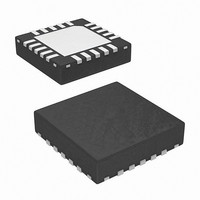ISL97801ARZ Intersil, ISL97801ARZ Datasheet - Page 13

ISL97801ARZ
Manufacturer Part Number
ISL97801ARZ
Description
IC LED DRIVER AUTOMOTIVE 20-QFN
Manufacturer
Intersil
Type
Automotiver
Datasheet
1.ISL97801ARZ-TK.pdf
(19 pages)
Specifications of ISL97801ARZ
Topology
PWM, Step-Down (Buck), Step-Up (Boost)
Number Of Outputs
1
Internal Driver
Yes
Type - Primary
Automotive, Backlight
Frequency
850kHz ~ 1.15MHz
Voltage - Supply
2.7 V ~ 16 V
Voltage - Output
32V
Mounting Type
Surface Mount
Package / Case
20-VQFN Exposed Pad, 20-HVQFN, 20-SQFN, 20-DHVQFN
Operating Temperature
-40°C ~ 105°C
Current - Output / Channel
1A
Internal Switch(s)
Yes
Efficiency
90%
Lead Free Status / RoHS Status
Lead free / RoHS Compliant
Available stocks
Company
Part Number
Manufacturer
Quantity
Price
Company:
Part Number:
ISL97801ARZ-TK
Manufacturer:
Intersil
Quantity:
900
Part Number:
ISL97801ARZ-TK
Manufacturer:
INTERSIL
Quantity:
20 000
Company:
Part Number:
ISL97801ARZK
Manufacturer:
Intersil
Quantity:
1 971
Over Temperature Shutdown
An internal sense circuit disables PWM switching if the die
temperature exceeds +135°C. Switching is re-enabled when
the temperature falls below +100°C.
Internal 5V LDO
An internal LDO between VIN and VDC regulates VDC to
5V, to power control and gate drive circuits when VIN
exceeds 5.1V. In normal operation decouple VDC with at
least 3.3µF. In applications where the input supply is less
than 5.5V, VDC should be tied directly to VIN.
LED Temperature Control
LED lifetime reduces dramatically with elevated
temperature. An over temperature control circuit utilizing the
thermistor voltage at TEMP reduces the LED bias current
when VTEMP exceeds the threshold voltage on TMAX. To
minimize noise injection use a potential divider between
VDC and GND to set the voltage on TMAX, as shown in
Figure 34. The value of TMAX for a specific threshold
temperature is determined by the choice of thermistor
temperature coefficient. Disable the function by connecting
the TMAX pin to VDC and TEMP pin to GND.
VBAT
FB Level Adjust
Current
FIGURE 34. OVER-TEMPERATURE CIRCUIT
ISL97801
VBAT FAULT
SWS1 SWS2
FIGURE 33. EXTERNAL OVP CIRCUIT
VIN
EL7801
+
-
SWD1
SWD2
LDO
VIN
FB
VDC
Temp
Compensation
0.47uF
13
CREG
10µH
ZOVP
L1
TM AX
G ND
TEM P
100
R1
RM2
RM1
80k
20k
Thermistor
Close to
LED's
RT
0.5
RSENSE
10K
VOUT
COUT
20µF
ISL97801
Component Selection
Input Capacitor
Switching regulators require input capacitors to deliver peak
charging current and to reduce the impedance of the input
supply. This reduces interaction between the regulator and
input supply, improving system stability. The high switching
frequency of the loop causes almost all ripple current to flow
in the input capacitor, which must be rated accordingly.
Considerably more input current ripple is generated in buck
mode than boost mode. In buck mode input current is
alternately switched between I
current flow in the input capacitor is given by:
Where: D = Duty Cycle
The input current is maximum for D = 0.5 and when I
approaches current limit (2.4A) giving a value of around
1.2A.
A capacitor with low internal series resistance should be
chosen to minimize heating effects and improve system
efficiency, such as X5R or X7R ceramic capacitors, which
offer small size and a lower value of temperature and voltage
coefficient compared to other ceramic caps.
In boost mode input current flows continuously into the
inductor, with an AC ripple component proportional to the
rate of inductor charging only and smaller value input
capacitors may be used. It is recommended that an input
capacitor of at least 10µF be used. Ensure the voltage rating
of the input capacitor is suitable to handle the full supply
range.
In automotive applications the input capacitor can be
protected from exposure to high voltages present during
fault conditions (load dump) by connecting it downstream of
the fault protection switch, as shown in Figures 39 and 40.
Inductor
Careful selection of inductor value will optimise circuit
operation. Inductor type and value influence many key
parameters, including ripple current, current limit, efficiency,
transient performance and stability. Internal slope
compensation has been optimised for inductor values
between 4.7µH and 10µH. Ensure the inductor current rating
is capable of handling the current limit value in the
configuration used (2.4A for buck, 3.5A for boost). If an
inductor core is chosen with too low a current rating,
saturation in the core will cause the effective inductor value
to fall, leading to an increase in peak to average current
level, poor efficiency and overheating in the core.
I
CAPRMS
=
I
OUT
•
(
D D
–
2
)
OUT
and zero. The rms
April 2, 2007
OUT
(EQ. 3)
FN6428.1











